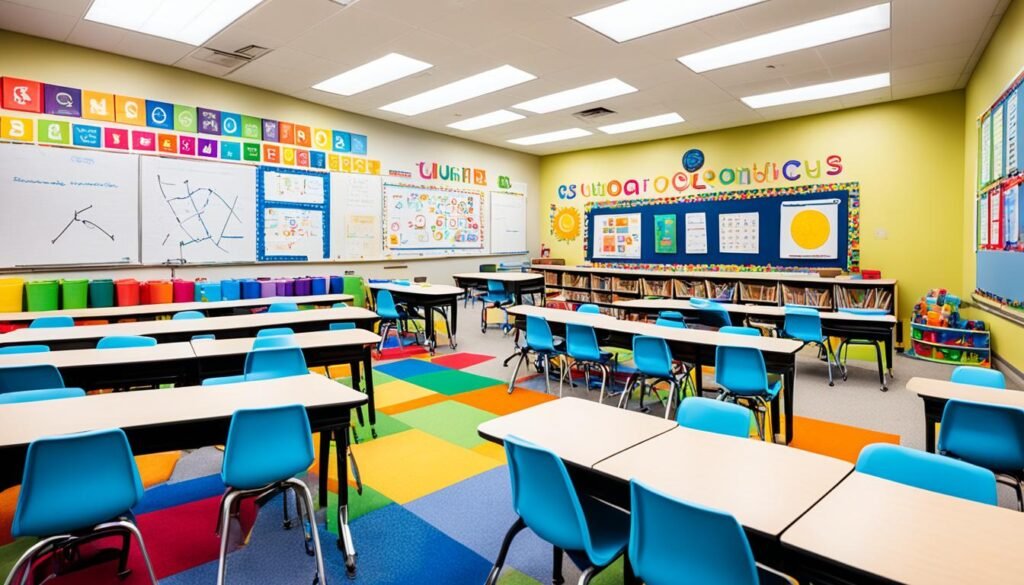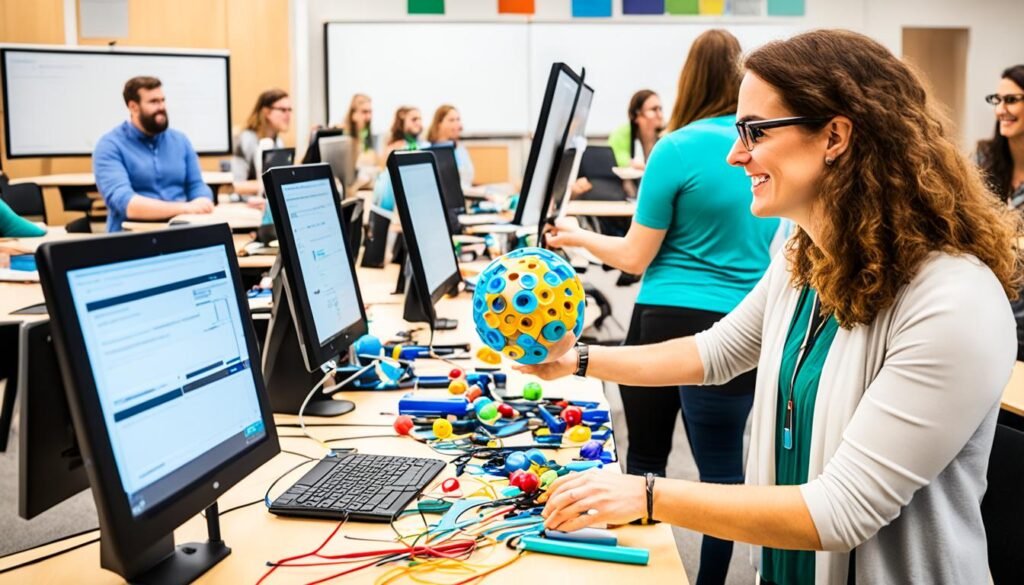A PhD in Education helps scholars change how we teach and learn in this century. It teaches new ways to teach, uses the latest teaching methods, and focuses on learning for life. With this degree, you can do many jobs in education, like teaching or leading schools.
This program can be done online, making it perfect for people already working. To get in, you need a master’s degree, good grades, and a love for teaching. The cost can change, but there’s often help with paying for it.
In short, a PhD in Education gives you the tools to make education better. You learn new teaching methods, how to lead in education, and how to change teaching and learning for the better.
Also Read: The Path To Teaching: Benefits Of An Education Degree
Key Takeaways:
- A PhD in Education program focuses on redefining pedagogy and integrating cutting-edge teaching approaches.
- Graduates are prepared for diverse roles in education, from teaching to leadership positions in schools, districts, and higher education.
- The program offers a flexible online format, allowing working professionals to advance their careers while continuing their studies.
- Admission requirements typically include a master’s degree, a strong academic record, and a demonstrated passion for education.
- A PhD in Education provides the advanced knowledge and skills necessary to drive positive change in the field of education.
Also Read: Achieving The Pinnacle: Understanding The Highest Level Of Education
Redefining Pedagogy in the 21st Century
The 21st century is changing the way we teach and learn. We’re moving beyond just memorizing facts. Now, it’s all about engaging students to think critically and solve problems. Learning is more hands-on and focused on the student’s experience.
Also Read: Advancing Your Career With The American College Of Education
From Rote Learning to Learner-Centric Approaches
Today, digital media and multitasking have reshaped education. Sharing and getting information is easy, thanks to the internet. Now, learning is more about creating knowledge. Teachers are being challenged to come up with new ways to teach, keeping their students interested.
Also Read: Shaping Futures: The Role Of Educators In Education Careers
From Theoretical Knowledge to Practical Hands-On Experiences
Education now is all about hands-on experiences. Students don’t just sit and listen anymore. They’re involved in activities and discussions. This gets them to apply what they learn to real life.
Also Read: Digital Academia: Navigating The World Of Online Courses
From Teacher-Oriented to Student-Oriented
In the past, teachers took the spotlight in education. But now, it’s all about the students. Teachers must meet the different needs of today’s learners. This means always finding fresh ways to teach, keeping students motivated.
From Memorization to Innovation
Memorizing facts isn’t everything anymore. Instead, students are pushed to think and create. They’re encouraged to use what they learn to tackle tough problems. This approach brings out their innovation and critical thinking.
Adapting to these educational changes is key for students to do well in the 21st century. Success now means being able to adjust, think creatively, and work as a team.
Theories of Education: From Behaviorism to Connectivism

Education theories have changed over time. We moved from old ways like behaviorism to newer ideas such as cognitivism and constructivism. In the 21st century, we’re focusing more on connectivism in learning. Connectivism says knowledge comes from both experiences and thinking, not only from what we’ve already done.
Integrating Connectivism into Learning Theories
This new way of looking at how we learn is especially important for Generation Z. These young people have always been around lots of technology. Teachers can use connectivism to change how students learn. They can make learning better match how today’s students like to learn.
Reshaping Knowledge Acquisition
Adding connectivism to old learning theories is making educators think differently. Now, we see technology and being connected online as very important for learning. It lets students learn in new and exciting ways.
With connectivism, teachers can create lessons that work well for today’s students. This helps students stay interested, remember what they learn, and use their knowledge in real life.
Innovative Teaching Methods for Engaged Learning

Today’s educators are turning to new ways to teach. They want to grab the attention of students in the 21st century. This means moving away from just talking at the front of the class.
Gamification: Teaching Through Games and Engaging Stories
Gamification makes learning feel like playing a game. It uses fun stories and game play to teach. This approach keeps the lesson fun while still meeting educational goals.
Collaborative Learning: Fostering Teamwork and Peer Learning
Working together in class helps students learn from each other. This method replaces single workspaces with shared digital spaces. Here, students can collaborate and share thoughts easily.
Flipped Classroom: Reversing Content Delivery and Application
The flipped classroom changes how students learn. They watch lessons at home and then work on them together at school. This way of teaching encourages deeper learning and critical thinking.
These methods make learning more exciting and interactive. Teachers add technology and hands-on activities to their lessons. They aim to create a classroom where students are eager to participate.
More Innovative Approaches
Teachers are trying new ways to make learning fun and effective. One method is spaced learning. It means going over the same lesson multiple times, but not all at once. This lets students retain and understand the information better.
Crossover learning mixes traditional class learning with fun activities. These can include visits to museums, attending seminars, or joining after-school programs. By doing this, it makes learning more exciting. It also helps students ask questions and do hands-on activities, boosting their interest in the subject.
Spaced Learning: Repetition with Intervals
Spaced learning is all about repeating lessons with breaks in between. This method helps students remember and understand the material. Putting content in front of students more than once keeps it in their minds. This leads to better knowledge about the topic over time.
Crossover Learning: Formal and Informal Environments
Crossover learning mixes traditional class setup with the excitement of informal learning. It includes visits to places like museums and participating in unique programs. This method makes learning more fun and engaging. It also encourages students to explore new ideas and gets them to ask more questions. The hands-on activities help kids understand difficult topics better.
Self-Learning: Nurturing Curiosity and Independent Exploration
One approach to boost learning is through self-learning. It means allowing students to find and study topics on their own. This method encourages students to be curious and look for answers themselves. It also helps them improve their research skills. By doing this, students become better at thinking critically. These are important skills for their future success, especially in today’s learning environments.
PHD In Education: Exploring Cutting-Edge Pedagogies

A PhD in Education looks deeply into new teaching methods. These methods help all kinds of students learn better. For example, VAK teaching shows that students may like to learn in different ways. Some might do best when they see things, others when they hear information, and some when they can touch and interact with it.
VAK Teaching: Catering to Visual, Auditory, and Kinesthetic Learners
In a PhD program, educators learn how to use VAK teaching. They make lessons with pictures, sounds, and physical tasks. This way, all students can connect with the lessons. It makes learning a fun and engaging process for everyone, improving how much they remember.
Introducing Technological, Economic, and Cultural Forces
Learning in a PhD program also covers the big changes in education today. Students explore the impacts of technology, economy, and culture. This helps them stay up-to-date in their teaching methods. It’s all about making smart choices that benefit student learning.
Promoting Experiential Learning and Lifelong Learning
Yet another focus is on teaching grads how to keep learning themselves. This helps them stay sharp and offer the best education. They encourage students to always be curious and learning, preparing them for today’s job market.
Curriculum Reform: A Collaborative Effort

Curriculum reform is a big change that needs everyone’s help. This includes edtech companies, schools, teachers, and parents. By using a democratic method, everyone has a say in making new curriculum models for 21st-century students.
Involving All Stakeholders: Edtech Companies, Schools, Teachers, and Parents
For curriculum reform to work, everyone must work together. Edtech companies bring new ideas on how to use innovative technologies to improve learning. Schools and teachers know how to put these ideas into practice. Parents help develop student behavioral components, impacting education both in the U.S. and around the world.
Comparative Analysis: American vs. International Educational Systems
Looking at how education is different in the U.S. compared to countries like Finland, Germany, India, and China can teach us a lot. We can learn from what they do well to make our education better. This can lead to improved curriculum and learning outcomes in the U.S.
Teachers, parents, edtech companies, and others working together can really make a difference. We can take good ideas from around the world to make our education system even better.
Bridging the Educational Gap

The United States has not always been at the top when it comes to education. Countries like Finland, Germany, India, and China do better in many areas. They excel in teaching methods, technology, and the material students learn. Looking at how these advanced education systems work can help the U.S. catch up.
Learning from Countries with Advanced Education Systems
When we compare the U.S. to these leading countries, we see what’s missing. We learn about the cool technologies and curricula they use. Also, we see why their education is more challenging, which leads to better results. By learning from them, we can make our teaching and materials stronger. This will make sure all students get a good education.
Strengthening Curriculum and Learning Outcomes
By looking internationally and working together on curriculum development, the U.S. can improve. We can learn from what others are doing right. By improving our programs, we can better prepare students for college and jobs. This is about enhancing what we teach and how well students do in school.
Developing Equitable and Innovative Solutions
Creating new and fair ways to teach everyone is key to overcoming the education gap. We should look at new teaching tools and ways to change policies. This will boost the quality of education and how well students do nationwide.
Teacher Education and Professional Development

Getting teachers ready to use new teaching ways and educational tech well is key for our school system. A PhD in Education isn’t just about getting more teaching knowledge. It also focuses on keeping those teaching skills up to date.
Continuous Advancement of Didactic Skills
Graduates from these PhD programs learn to pick the best new technologies and teaching ways. This helps make students more interested and improves their learning. By supporting the growth of teachers and education leaders, these programs help make teaching and learning better. They do this by pushing for new and improved teaching plans and educational study. This effort helps to combine the latest tech and teaching methods in classes all over.
Developing and Selecting Innovative Technologies and Methods
These higher-level programs get education leaders up to speed with the newest teaching methods and inventive technologies. This ensures that they can use tech well and create lesson plans that meet the modern student’s needs. By encouraging teachers to always learn and do research, PhD in Education programs help graduates choose the best teaching methods and technologies. This choice leads to student success.
Conclusion
A PhD in Education gives scholars the tools needed for modern teaching and learning. It changes how we teach by introducing new methods and supporting life-long learning. Graduates help lead improvements in teaching with tools like gamification, team learning, and new learning theories. They also take on key roles in schools and education organizations.
These programs also aim to make the U.S. education system stronger and more globally competitive. They focus on helping teachers keep pace with new technologies and teaching methods. By doing so, they make sure 21st-century learning approaches are used across the country.
Getting a PhD in Education means making a big impact. It affects students, teachers, and how we all learn. This higher education degree helps America’s education system stay up-to-date with changes in the world. It’s about preparing everyone for a future full of new tech, economy, and cultural influences.
FAQs
Q: What is a PHD in Education?
A: A PHD in Education is a doctoral degree program that focuses on advanced education research, leadership, and policy.
Q: What are the admission requirements for a PHD in Education program?
A: Admission requirements for a PHD in Education program typically include a master’s degree, strong academic background, letters of recommendation, a statement of purpose, and in some cases, standardized test scores like the GRE.
Q: What is the difference between an EDD and a PHD in Education?
A: An EDD (Doctor of Education) typically focuses on practical applications of research in education leadership, while a PHD in Education emphasizes theoretical research and academic scholarship.
Q: How long does it take to complete a PHD in Education program?
A: The length of time to complete a PHD in Education program can vary but typically takes around 3-5 years of full-time study.
Q: What kind of career opportunities are available with a PHD in Education?
A: Graduates with a PHD in Education can pursue careers as university professors, educational researchers, policy analysts, school administrators, and consultants in the field of education.
Q: What is the tuition and fees for a PHD in Education program?
A: The tuition and fees for a PHD in Education program can vary depending on the institution, program duration, and whether the student is studying full-time or part-time. It’s recommended to check with the specific school of education for accurate pricing.
Q: Can I specialize in a specific area of education with a PHD in Education?
A: Yes, many PHD in Education programs offer specializations in areas such as educational leadership, policy development, curriculum design, or educational technology.





